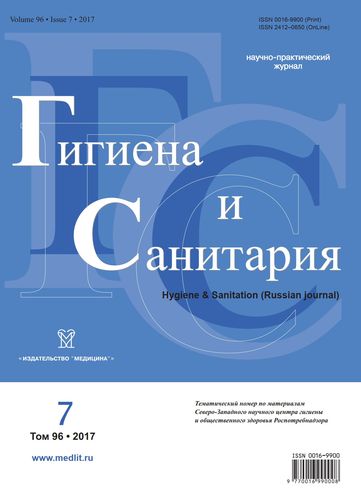Study of working conditions in patients with occupational polyneuropathy of upper extremities
- Authors: Kochetova O.A.1, Malkova N.Y.1,2
-
Affiliations:
- North-West Public Health Research Center
- North-Western State Medical University named after I. Mechnikov
- Issue: Vol 96, No 7 (2017)
- Pages: 636-641
- Section: OCCUPATIONAL HYGIENE AND MEDICINE
- Published: 15.07.2017
- URL: https://ruspoj.com/0016-9900/article/view/638424
- DOI: https://doi.org/10.47470/0016-9900-2017-96-7-636-640
- ID: 638424
Cite item
Full Text
Abstract
Autonomous sensory polyneuropathy of upper extremities is one of the most common occupational diseases of peripheral nervous system. Findings of the study of working conditions in two major worker jobs in which occupational polyneuropathies of upper extremities are prevalent, namely: house-painters and plasterers, as well as mining job workers (underground miners, shaft miners, breakage face miners) are reported. Hygienic investigations envisaged detailed studies of working conditions in workers with diagnosed occupational peripheral nervous system disease. The intensity and hardness of working process, illumination level, spectral noise characteristics, noise, vibration, temperature, humidity, and air velocity levels, as well as adverse chemical concentrations in workplace air were assessed. House-painters as well as miners were found to work with pronounced physical overloads, working conditions being classified as 3.2-3.3 (2-3 degree harmful) according to indices of working process hardness. In spite of new technologies being introduced into the working process, manual labor part in these jobs still remains to be the great. Comparison of findings revealed certain differences in some characteristics of working process hardness. Working process hardness shown by dynamic and static physical load on upper extremities was found to be the most significant harmful occupational factor resulting in polyneuropathy in house-painters and plasterers. Development of polyneuropathy in miners was caused by a combination of adverse occupational factors: working process hardness, local vibration, cold microclimate. Our findings indicated the importance of the study of health state in painters and miners. Working conditions must be taken into account in the process of development of preventive and remedial measures for occupational polyneuropathy treatment.
About the authors
O. A. Kochetova
North-West Public Health Research Center
Author for correspondence.
Email: noemail@neicon.ru
ORCID iD: 0000-0003-2740-1288
Russian Federation
Natalia Yu. Malkova
North-West Public Health Research Center; North-Western State Medical University named after I. Mechnikov
Email: lasergrmal@mail.ru
ORCID iD: 0000-0002-0426-8851
MD, PhD, DSci., chief researcher of Department of hygiene’s of the North-West Public Health Research Center, St.-Petersburg, 191036, Russian Federation; I.I. Mechnikov North-Western State Medical University, Saint-Petersburg 191015, Russian Federation; North-West Public Health Research Center.
e-mail: lasergrmal@mail.ru
Russian FederationReferences
- Artamonova V.G., Mukhin N.A. Occupational Diseases [Professional’nye bolezni]. Moscow: Meditsina; 2006. (in Russian)
- Izmerov N.F., ed. Professional Pathology: National Guide [Professional’naya patologiya: natsional’noe rukovodstvo]. Moscow: GEOTAR-Media; 2011. (in Russian)
- Milutka E.V., Dedkova L.E. Professional Diseases of the Peripheral Nervous System from Physical Overload and Functional Overstrain [Professional’nye zabolevaniya perifericheskoy nervnoy sistemy ot fizicheskikh peregruzok i funktsional’nogo perenapryazheniya]. St. Petersburg: SZGMU im. I.I. Mechnikova; 2014. (in Russian)
- Kochetova O.A., Mal’kova N.Yu. Features of professional polyneuropathies in the practice of a neurologist-occupational pathologist. In: Materials of the XII All-Russian Congress «Profession and Health» of the V All-Russian Congress of Occupational Physicians [Materialy XII Vserossiyskogo kongressa «Professiya i zdorov’e» V Vserossiyskogo s’’ezda vrachey-profpatologov]. Moscow: 2013; 272–3. (in Russian)
- Mal’kova N.Yu., Kochetova O.A. Study of working conditions of painters. In: Meltser A.V., Yakubova I.Sh., ed.: Preventive Medicine-2016: Materials of the All-Russian Scientific-Practical Conference with International Participation. [Profilakticheskaya meditsina-2016: materialy Vserossiyskoy nauchno-prakticheskoy konferentsii s mezhdunarodnym uchastiem]. St. Petersburg: SZGMU im. I.I. Mechnikova; 2016: 50–2. (in Russian)
- R 2.2.2006–05. Guidance on hygienic assessment of working environment factors and labor process. Criteria and classification of working conditions. St. Petersburg; 2005. (in Russian)
- Nabieva G.V. Prevalence and clinical features of occupational diseases of the hands of workers engaged in drilling oil wells. In: Materials of the All-Union Conference «Actual problems of professional pathology» [Materialy Vsesoyuznoy konferentsii «Aktual’nye voprosy professional’noy patologii»]. Moscow: 1990; 1(42): 159–60. (in Russian)
- Mal’kova N.Yu., Popov A.V. Study of working conditions in cases of occupational myofibrosis of the upper extremities. Ekologiya cheloveka. 2011; (12): 20–4.
- Izmerov N.F., ed. Guidance on Occupational Health [Rukovodstvo po gigiene truda]. Moscow: Meditsina; 1987. (in Russian)
- Retnev V.M., Shlyakhetskiy N.S., ed. Guidance on the Procedure for Conducting Preliminary and Periodic Medical Examinations of Employees and Medical Regulations for Admission to the Profession [Rukovodstvo o poryadke provedeniya predvaritel’nykh i periodicheskikh meditsinskikh osmotrov rabotnikov i meditsinskikh reglamentakh dopuska k professii]. St. Petersburg: SPbMAPO; 2001. (in Russian)
Supplementary files









